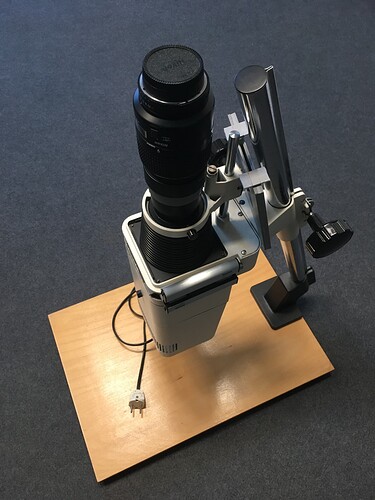Hi all,
After a long absence, and many iterations on my scanning setup, I wanted to share from where I started to where I ended, as well as my process and thoughts to arrive where I ended with so many help from the posts here and elsewhere on the web. This is to give back to all who provided tips and ideas. Perhaps my findings are of use for someone else out there.
My starting point:
And what I ended up using eventually:
What I wanted:
- Rigid connection between film and DSLR with automatic alignment
- Reliable method to keep my film flat
- Possibility to use both collimated and diffused light
- Full-spectrum daylight light-source
- A way to tackle dust
- Good and reliable focus across the whole negative, i.e. a lens with “flat field”
- Options for 35mm, 120 film, and mounted slides
- No setup time
- Low-cost
How I arrived there:
I purchased an old enlarger and flipped it up-side-down. I then needed a reliable film holder with feedthrough, so I purchased some foamed PVC modeling board since that is cheap, easy to work with, and is a soft plastic that will not scratch my negatives. Using this, I constructed a holder as follows, that has an opening exactly the thickness of a negative. I simply glued some spare negative with 10 second glue in between two foam boards and chamfered the entrance and exit edges:
To remove dust when entering to-be-scanned negatives, I added two carbon fiber brushes for cleaning of LP records, one top, and one bottom:
I made in the same way a similar holder for mounted slides and for 120 film:
And used a square piece of opal glass below it to act as a diffuser of the collimated light from the enlarger. After many tests, I concluded that there was no real advantage in using collimated light, other than more dust showing up, as others had investigated in detail elsewhere on this forum, so my scanning is always with the diffuser in place now.
As a full-spectrum daylight source I purchased a Solux bulb (hard to find) and a transformer to power it, and mounted that in place of the old tungsten bulb that came with the enlarger:
Next up was finding the best lens option for 1:1 picture taking. I used millimeter paper in place of a negative and tried various reversed enlarge lenses (two Nikons and a Schneider), and ended up concluding that the Nikon 50mm 2.8 was best, but still showed some softness in the corners due to a not perfect flat field. Below are some pictures of a reverse mounted enlarger lens and a typical scan of mm paper, used to check for sharpness across the scanned area at 1:1 enlargement:
In the end, I purchased a used 105 f/2.8 AFD micro Nikkor that I mounted on its larger solid outside threat, using two lens hoods and a piece of PVC reducing pipe:
This way, the lens could autofocus by pushing it’s internals back-and-forth without moving the mounted camera up and down. This is perhaps a typical option for this lens, but this worked out really well, since I found out that I could re-calibrate the autofocus specifically for the 1:1 to 1:1.1 enlarging range using the menus of my DSLR and I actually could reliably use autofocus for each following negative image scan, which really helped in speeding up the scanning process. Recalibrating the AF using mm paper looks like so:
To confirm reliable operation, sharpness, and flatness of field, I purchased Valdimir’s test target (google that) and confirmed reliable sharpness across the entire frame using AF, always reliable alignment without need for adjustments, and about 40-45 LPI, which is about right for the 16 Mpixel scans as my DSLR allows for:
I scan my negatives shortly after development and have, thanks to the automations and LP record brushes virtually no need for post processing of dust etcetera. I scan at fixed 100 ASA, with aperture priority, letting the shutter speed (typically 1/100 or so) be automatically determined by the camera, while keeping an eye on the histogram and correcting with exposure +/- for one or two stops where needed. AF is per scanned image and works reliably. A typical example scan of Fomapan 100 film, developed in HC110, using NLP for conversion without any adjustments is:
Cheers,
Arno




















